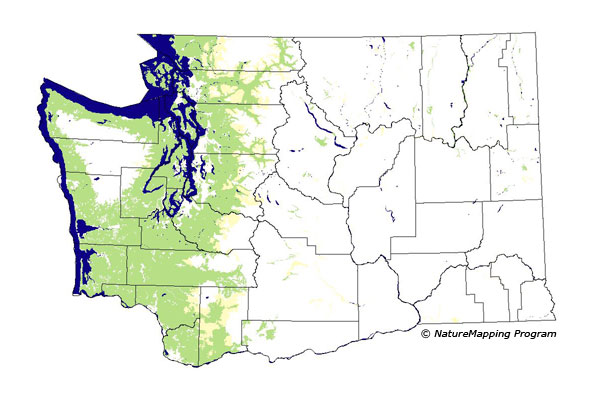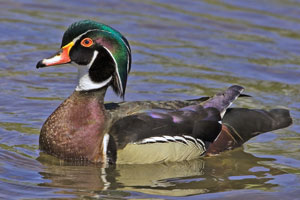


Wood Duck (Aix sponsa) Also known as the Woodie, Carolina duck, Swamp Duck, Squealer Duck and Summer Duck What they look like: Wood Duck drakes are the most vividly colored of all North American ducks. The head and crest are green and purple, outlined with white lines. The throat and neck are white. The breast is chestnut brown with white flecks. The lower breast is tan. The wings are metallic blue and green; sides are buff and black. The drake has red eyes. His bill is red with a black tip. The legs and feet are dark yellow.
The hen is mostly brownish-olive, with white streaks on the breast. She has dark eyes with a tear-drop shaped white eye ring (see photos below). Her bill is dark gray. The legs and feet are dark yellow like the male.
What they sound like: The drake's high-pitched whistle, "jeeeee" and the hen's low, owl-like "whoo-w-eet" call can be heard as they fly. Listen to calls of this species »
What do you call a group of ducks? Where they live: The Wood duck breeds from British Columbia south to California, and from Montana east to Nova Scotia and south to Texas and Florida. They are absent from Rocky Mountains and Great Plains. Winters near Pacific Coast north to Washington, and to New Jersey in East, rarely farther north. All ducks live near water. They prefer swamps and forests close to freshwater wetlands, ponds, creeks, and rivers. What they eat: Wood ducks are mainly vegetarian (plant eating). They feed on aquatic plants, seeds, nuts and fruits. They also eat insects, snails, tadpoles, and salamanders. Wood ducks are "dabbling" ducks and search for food while swimming. 
Nesting: The breeding season for wood ducks begins in April. The hen will pull out some of her down feathers around her belly to line the nest hidden in a natural tree cavity or a man-made nest box. The nest can be up to 50' (15 m) off the ground. The female lays a clutch (eggs laid at the same time) up to 15 cream colored eggs. A normal clutch has 6-10 eggs. The hen incubates the eggs for 25 to 37 days. The young grow quickly and can fly at about 8 to 10 weeks. The young leave the nest soon after hatching. They jump from the nesting cavity, often high up in a tree, to the ground or water below. Conservation: The Wood Duck was hunted nearly to extinction during the late 19th and early 20th centuries. Due to conservation efforts, there are now over a million Wood Ducks living in North America. Did You Know?
Animal silhouettes available to purchase » Photos by Natures Pics Definitions: Clutch - a number of birds hatched at the same time. Drake - adult male duck. Hen - adult female bird. |